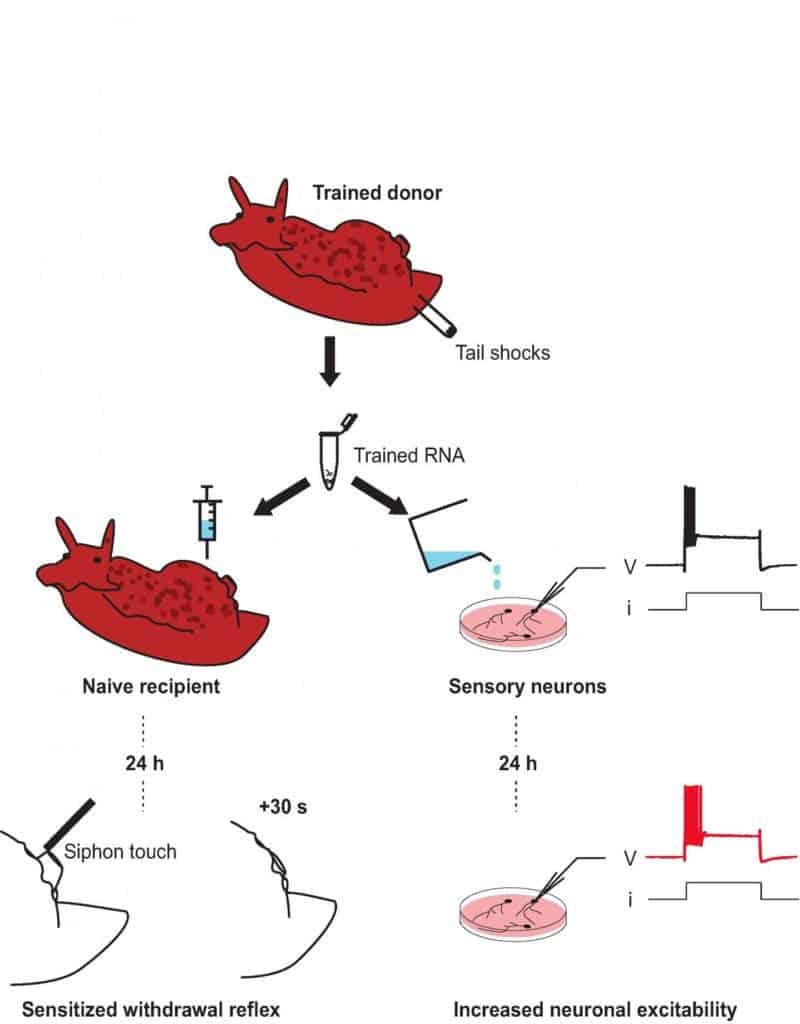
An exciting new research study suggests the possibility that some memories can be transferred between organisms. Scientists extracted ribonucleic acid (RNA) from a trained sea snail and implanted it into an untrained snail, whose behavior then matched that of the donor animal.
Where is my mind?
When the brain deems an experience meaningful enough, it will transfer that information from short-term storage — the temporary file cabinet which holds information like where you put your car keys or the phone number of a person you just met — to your long-term memory, where information is stored so that it can be accessed at a later time. Scientists think that this record is made in the brain by strengthening the connections between groups of neurons that participate in encoding the experience — a pattern of connections which is referred to as an engram.
In 2012, MIT researchers identified the particular brain cells in the hippocampus that were active only when a mouse was learning about a new environment. They then proceeded to identify which genes were activated in those cells and added the gene for channelrhodopsin-2 (ChR2), a light-activated protein used in optogenetics, into a genetically engineered mouse. Using tiny optical fibers embedded in the animals’ skulls, the researchers could deliver pulses of light to hippocampal dentate gyrus neurons, thereby manipulating their activity.
The mice were introduced to a new environment and were then left to acclimate themselves with a few minutes of exploration. A mild foot shock was then suddenly introduced, causing the mice to fear that environment. The activated brain cells were tagged with ChR2. Later, the mice were introduced in a totally different environment, with an obviously different maze and smell, and were again left there to explore. A pulse of light was fired onto the neurons involved in the first experience, causing the fear memory to switch on and the mice to quickly enter a defensive, immobile crouch. The rodents had, essentially, been fear conditioned.
“Our results show that memories really do reside in very specific brain cells,” co-author Xu Liu stated at the time, “and simply by reactivating these cells by physical means, such as light, an entire memory can be recalled.”
This landmark research study showed that long-term memories are stored in modified connections between brain cells, which can be recalled on command. However, recent evidence also points to an alternative explanation: memories might be stored in changes in gene expression induced by non-coding RNA (ncRNA) — an RNA molecule that is not translated into a protein.

David Glanzman and colleagues at the University of California, Los Angeles, trained a California sea hare (Aplysia californica) to form a conditioned response by stimulating their tail, triggering an involuntary defensive reflex. The team then proceeded to extract RNA from these trained snails and injected it into untrained animals. The latter group inherited a similar sensitized response.
Researchers also showed that RNA extracted from trained snails increased the excitability of cultured sensory neurons, which were obtained from untrained animals and which controlled the involuntary reflex.
The findings provide evidence that RNA may be involved in memory modification, which suggests that memory storage is far more complex than meets the eye.
Reference: RNA from Trained Aplysia Can Induce an Epigenetic Engram for Long-Term Sensitization in Untrained Aplysia, eNeuro.


